

Catch Fish with
Mike Ladle
Information Page
SEA FISHING
For anyone unfamiliar with the site always check the FRESHWATER, SALTWATER and TACK-TICS pages. The Saltwater page now extends back as a record of over several years of (mostly) sea fishing and may be a useful guide as to when to fish. The Freshwater stuff is also up to date now. I keep adding to both. These pages are effectively my diary and the latest will usually be about fishing in the previous day or two. As you see I also add the odd piece from my friends and correspondents if I've not been doing much. The Tactics pages which are chiefly 'how I do it' plus a bit of science are also updated regularly and (I think) worth a read (the earlier ones are mostly tackle and 'how to do it' stuff).
How things change
In 1983, with my pals Harry Casey and Terry Gledhill, I published the original book “Operation Sea Angler”. Our idea was to describe how we’d re-learned to catch sea fish since moving to Dorset about fifteen years earlier. To our surprise the book was an instant success and one of the main attractions to other sea anglers seemed to be some of our (then) novel and very successful approaches to sea angling success. A major source of improvement was the application of lure and fly fishing tactics to salt water situations, particularly from the shore. A further thirty-five years have now passed and all sorts of dramatic changes have taken place since then. Many of those changes have been documented in my blog pages but since weather, holidays and other commitments have slowed down my fishing lately I thought it might be worth looking back and seeing what can be learned.
Firstly, I’ll just outline where we were in the 1980’s by illustrating the lures being used at that time. My normal spinning tackle was a 12ft, 1.75lb T.C. ‘carp’ rod (now, due to chnges in carp fishing gear,regarded as a ‘barbel rod’ I suppose) and 8lb, clear nylon right through to the lure. Lots of big bass were caught on this set up and very few were lost although there was a considerably higher loss rate for lures caught on rocks and kelp than today. The old picture illustrates the lures in use at the time.
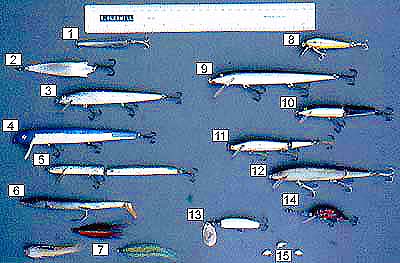
1 & 2: Pirk/wedge and Toby Spoon (used in early days and in deeper water)
3: ABU Killer (one of our first floating plugs. Bass up to 11 pounds were taken on these lures)
11: The 'Tesco Special' (this cheap, foreign made, floater was very effective for bass of all sizes)
12: Rebel J30S (for years this was a favourite. Responsible for many large bass including one of over 12 pounds)
4 & 5: Home-made floaters (Number 4 took bass of over 10-pounds and number 5 proved to be effective in sizes up to 12" long)
14: Rebel crayfish (this was useful for bass and was a very good wrasse lure)shallow divers and weedless soft lures also work well for wrasse.
9 & 10: Rapalas (until recently this was the most consistent shallow working floater) STILL ONE OF THE BEST PLUGS EASIER TO CAST ON BRAID THAN NYLON
8: Small Japanese slow-sinker (used for fry-feeders) SMALL PLUGS ARE ALWAYS HANDY FOR FRY FEEDERS, AS ARE MEPPS
6 & 13: Redgill and balsa-bodied Mepps (both were found to be useful in dirty conditions amongst bits of floating weed)
7 & 15: Streamer flies and floating maggot-flies (used with a fly rod for bass and mullet) MAGGOT FLIES ARE STILL EXCELLENT
We started off using traditional Toby spoons and similar lures and to be honest, although they catch fish, the places where it’s possible to use them are seriously restricted by tackle losses on snags. The introduction of buoyant plugs which fished close to the surface was a major improvement; “bassy ground” kelp, wrack, rocks and shallow water could be fished with reasonable confidence and once you got to know the places you were fishing lure losses dropped, on average, to one or two per season. A lot cheaper than bait for a season’s fishing. The best of the buoyant plugs are still very effective bass catchers and in recent years they have been joined by many “Japanese” models which incorporate moving weights to improve casting distance. To be honest distance was never really a problem for bass and with the introduction of gossamer fine braided lines it is hardly worth considering these days. The innovation of surface popping and sliding lures (a USA innovation) practically solved the snagging problem completely, although there are times when the bass seem more interested in sub-surface feeding than smashing into a popper.
A good fish caught on a Toby spoon adorned with a single hooked streamer fly
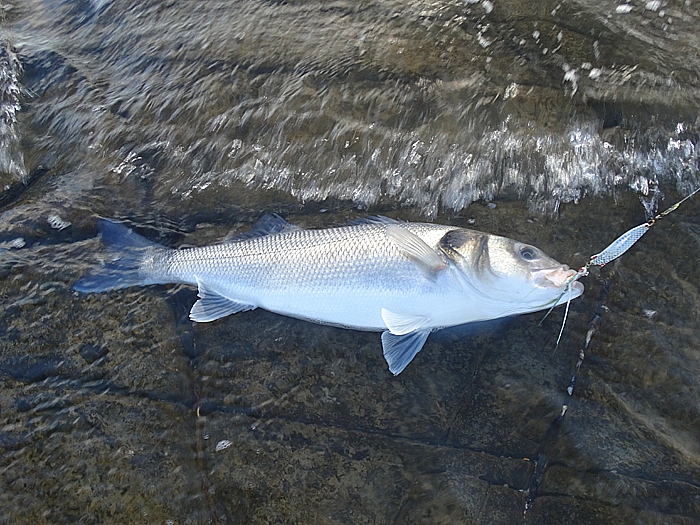
A modern Japanese plug - always a good bet for bass
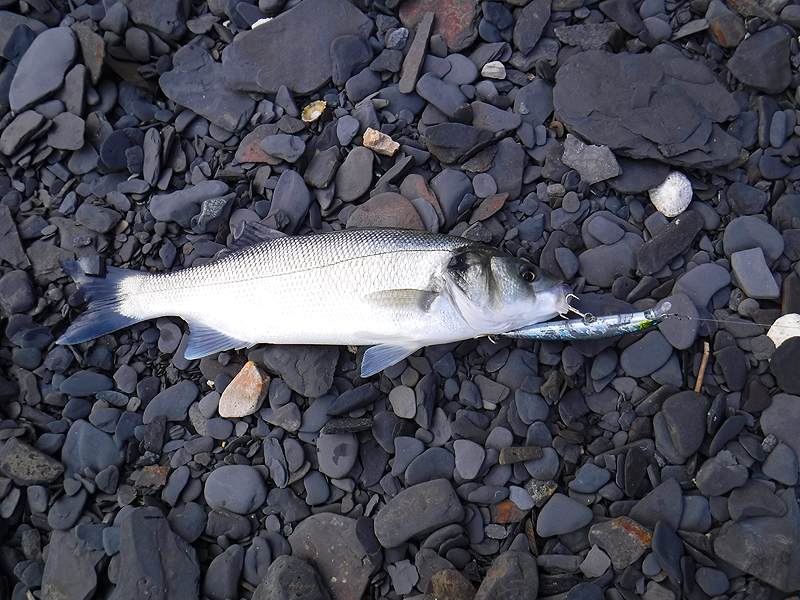
Surface poppers are still good particularly in calm, weedless, snaggy conditions.

Any lure with hooks which hang below the body, even a surface slider, is tailor made for catching loose, drifting weed and this can make many places virtually unfishable in disturbed conditions. Catching bits of weed on every chuck is very frustrating when big bass can be seen grovelling in the “soup”. The first, partial, solutions to this problem were Redgills fished behind a swivelled trace so that the swivel picked up some of the weed and gave a bit more fishing time; also the spinning blade of home-made balsa bodied Mepps lures which would sometimes deflect weed from the lure and had the benefit of tempting a few mullet (see the first montage picture). More recently the introduction of weedless soft plastics (again from the US of A’s black bass anglers) has practically solved the problem of loose weed and for that matter of snags. The only possible downside of these lures is that they may (although I’ve no evidence of it) fail to hook a few more fish than lures with exposed hooks. Since these weedless lures can be fished with nose weights of any size or totally weightless (my usual preference) there is scarcely any need for another type of lure. Some of them have proved so effective that a number of bass anglers have become almost “addicted” to their use. In general the softer and more flexible the plastic the better the action and the easier it is to hook fish but the downside of this is that the softest lures can be fragile and need frequent replacement (like every one or two fish) which can be expensive. All of these lures are likely to tempt wrasse as well as the target species and on flood tides over beds of wrack wrasse can be the most frequent catches.
A homemade, weedless, hybrid Slandra - pretty good for bass and wrasse.
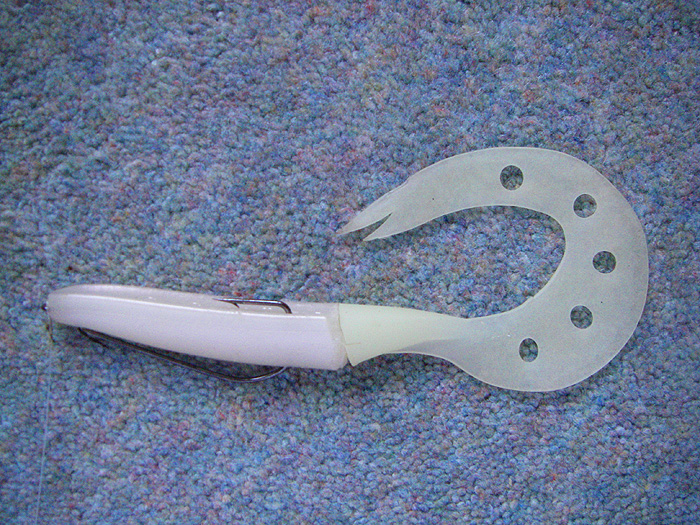
A bass nicely hooked on a weedless soft plastic Slandra.
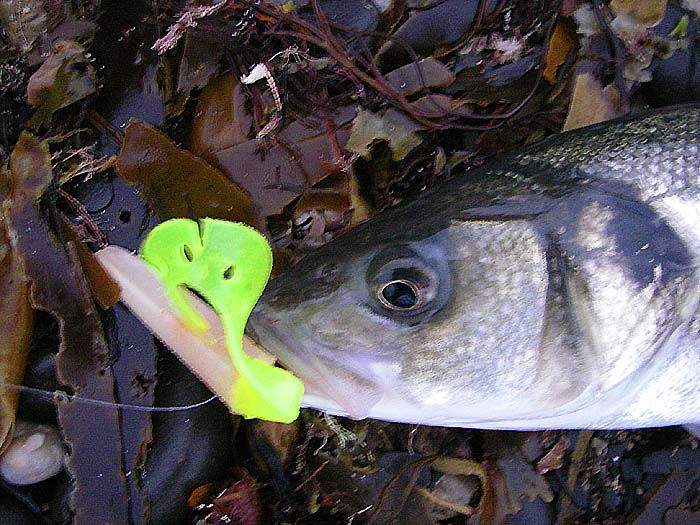
An Evo-Stick Redgill with a nose weight - consistent catcher of bass of all sizes.
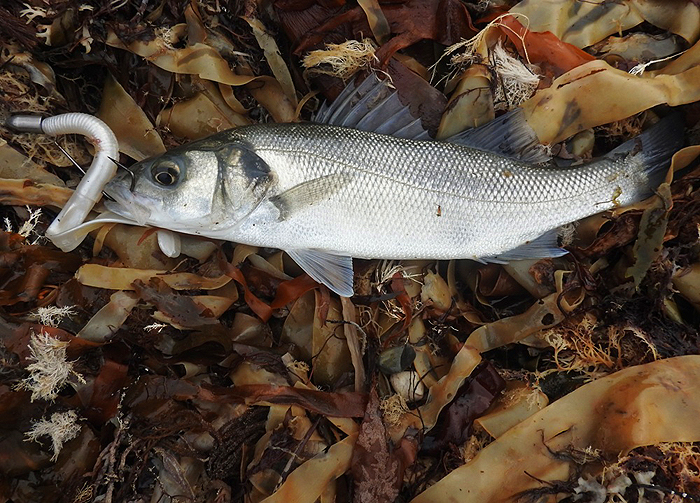
A Fiiish Black Minnow - good but delicate.
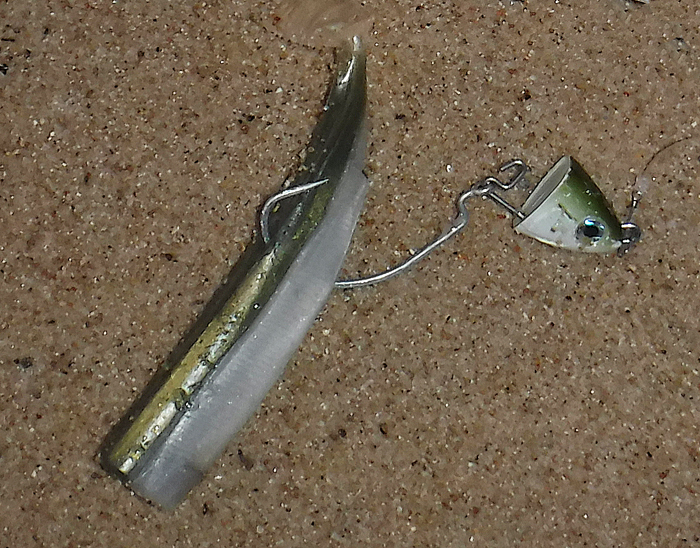
Nice wrasse on a soft plastic.
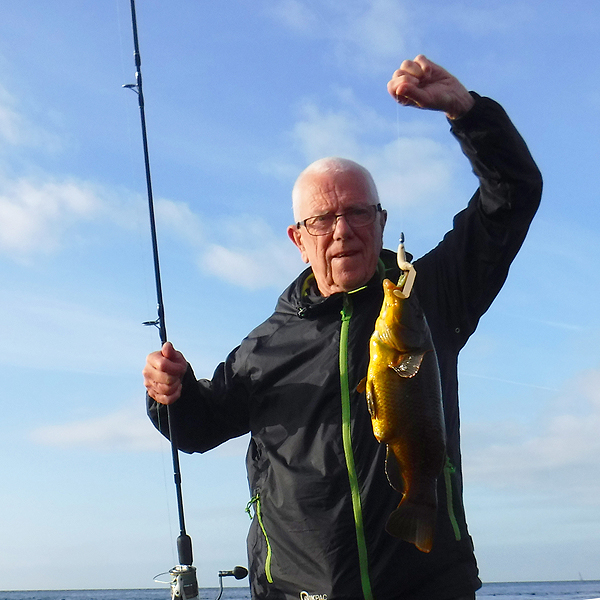
Spinning with lures is far from being the only way to catch bass and of course many other species are liable to be caught even when bass are the target. One of the major early improvements in our sea angling tactics was the use of ‘dry flies’ to tempt surface feeding mullet. In my forty-odd years experience there is little doubt that floating poly-maggots, with the added attraction of a few live maggots, are the best way to catch maggot-skimming-thicklips. Bass will also gorge themselves on Coelopa maggots and at times can be a nuisance to the mullet angler. However, it is possible to selectively catch bass on the fly gear by using fry imitations and streamer flies. Trial and error has shown that small plastic eels with waggy tails are as good as or better than most traditional flies and have caught, not only large numbers of bass but also pollack, mackerel, scad and garfish. Even the occasional mullet falls to these ‘flies’ although it is always doubtful whether they actually took them or were accidentally mouth hooked.
A big mullet caught on a maggot fly.

Into a bass on the fly.
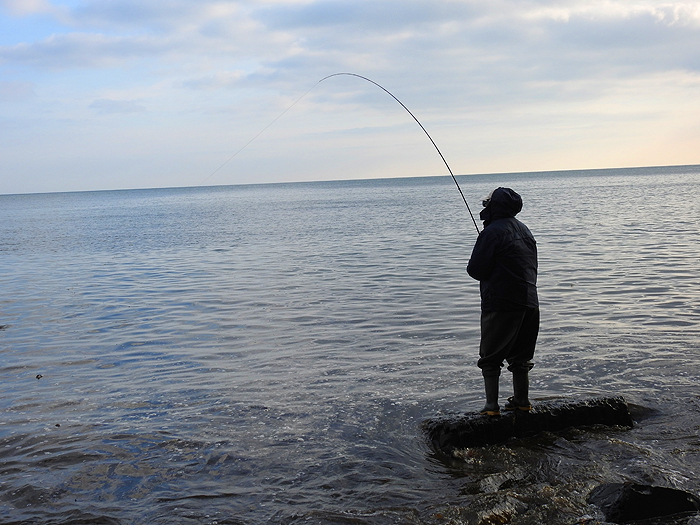
Not bad for six-pound nylon cast and a tiny Delta eel.
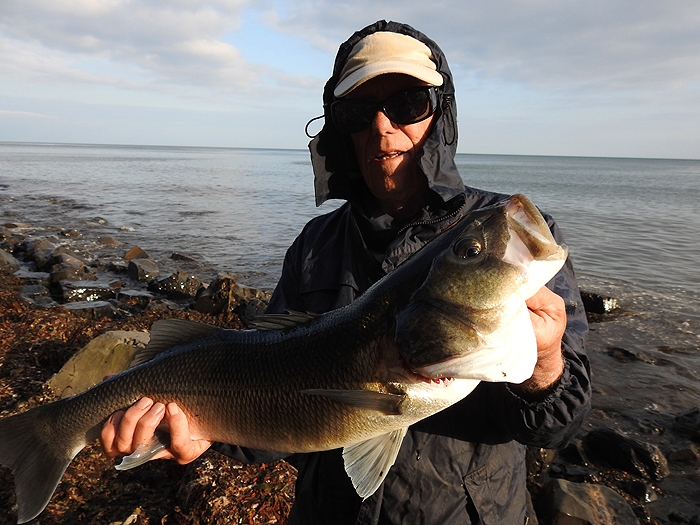
– PLEASE TELL YOUR TWITTER, FACEBOOK, EMAIL FRIENDS ABOUT THESE BOOKS.
BRAND NEW BOOK
"Fishing for Ghosts - Successful Mullet Angling"
written with David Rigden IT'S AVAILABLE FROM -ALSO THE NEW BOOK
“The Second Wave”
Written with Steve Pitts this is a SEQUEL TO THE BESTSELLER "Operation Sea Angler" IT'S AVAILABLE ON PAPER OR FOR YOUR KINDLE FROM -If you have any comments or questions about fish, methods, tactics or 'what have you!' get in touch with me by sending an E-MAIL to - docladle@hotmail.com